According to the ATF, the Mossberg Shockwave and Remington TAC-14 are classified as “other” firearms, meaning they are not handguns nor are they shotguns. It is not our intent to ignore ATF definitions, but it can be confusing to use the term “other” when describing these firearms. So, for less confusion, we will refer to them as firearms even though they shoot shotshells and slugs and have chambering descriptions in gauge and bore terminology.
Back in 2017, we tested the Mossberg Shockwave in 12 gauge, giving it an A grade. We expected as much — and less — from these sub-gauge models. “Less” meaning less recoil. The 12-gauge variants offer heavy recoil depending on the loads used. We also had some specialty 410 defense loads that we have used in 45 LC/410 revolvers and wanted to try them in one of these weapons.
We tested at 10 yards on plain cardboard sheets that measured 18 inches wide, the average width of a male torso. We fired slugs, birdshot and buckshot out of the 20-gauge weapons using Aguila 2.75-inch shells loaded with #2 buckshot, Federal Premium 0.75-ounce rifled slugs, and handloaded #8 birdshot shells, which one of our testers uses for skeet and sporting clays. For the 410, we used the same distance and target and loaded up with 3-inch Winchester Super X quarter-ounce slugs, 2.5-inch Federal Premium #8.5 birdshot shells, and Hornady Critical Defense loads with one 41-caliber FTX projectile and two 35-caliber round ball projectiles. We fired to determine pattern size and found that with specialty and buckshot loads, these tiny blasters were surgical, allowing us to easily keep patterns on the 18-inch wide target. Birdshot destiny patterns were pretty close to covering 18 inches, but we did note some shot flew at a wider pattern — something one should consider if you were to use these weapons for home defense. Note that using birdshot will more than likely cause a large shot pattern with not all projectiles hitting the target. We would stick with buckshot and specialty loads for home defense and leave the birdshot for dispatching large rodents and snakes.
Our initial process was to accurately fire on the cardboard with birdshot, then buckshot/specialty loads, followed by slugs. Since the projectiles are of different sizes, it was easy to discern the different hole sizes. We also followed this process to quickly compare load types on our 18-inch-wide target.
These three pump-action weapons feature a 14-inch barrel with a Cylinder-bore choke and use a Raptor pistol grip. All weapons functioned flawlessly, though we did find the 410 slower to reload. There was also a distinct preference for the Mossberg versus the Remington, or vice-versa, depending on what type of pump shotgun our testers had experience with. In our opinion, the Mossberg with the action lock lever behind the trigger guard allowed for fast manipulation without changing your grip. The ambidextrous safety on the Mossberg also gave it a slight edge over the Remington’s safety in the trigger guard behind the trigger. We’d feel empowered to protect our castle with any of these weapons, but we would lean toward the Mossberg. Here’s why.
Mossberg 590 Shockwave Model 50657 20 Gauge, $455
GUN TESTS GRADE: A
The Shockwave in 20 gauge substantially reduces felt recoil, which all users appreciated. We liked the strapped forend, which offered good grip security. Mossberg 500 or 590 users will easily adapt to this one.

| ACTION TYPE | Pump |
| CHAMBER SIZE | 3 in. |
| OVERALL LENGTH | 26.37 in. |
| CAPACITY | 5+1 (2.75-in. shells), 4+1 (3-in. shells) |
| WEIGHT UNLOADED | 4.95 lbs. |
| WEIGHT LOADED | 5.75 lbs. |
| BARREL LENGTH | 14.375 in. |
| FINISH | Matte blued |
| CHOKE | Cylinder bore |
| GRIP | Bird’s head-style, textured polymer |
| FOREND | Ribbed polymer w/ strap |
| FRONT SIGHT | Brass bead |
| TRIGGER PULL WEIGHT | 5.8 lbs. |
| SAFETY | Ambidextrous thumb |
| WARRANTY | Limited lifetime |
| TELEPHONE | (800) 363-3555 |
| WEBSITE | Mossberg.com |
| MADE IN | USA |
The Shockwave is based on Mossberg’s robust Model 590 action scaled down for 20 gauge. It was slick out of the box. The Shockwave wore a matte black finish that was well executed. The ribbed forend is thin and offers plenty of texture along with a nylon strap. Slip your hand between the strap and forend and your support hand is secure even with severe recoil. It also prevents your support hand from being pinched between the forend and front of the receiver.

We liked how the Raptor pistol grip flowed seamlessly into the receiver and liked the sling stud out the butt. This feature allows the user to attach a one-point sling, similar to how you would with an AR rifle or pistol. We like this feature.
The controls are like other Model 500 and 590 shotguns with an ambidextrous safety button located at the top rear of the aluminum alloy receiver. The Shockwave is equipped with a heavy-wall plain barrel that is actually 14.375 inches long. The barrel features a brass bead. In hand, the Shockwave is light, compact and extremely maneuverable. The trigger guard/trigger group was made of polymer.
At the range, we started with our 2.75-inch handloaded shells with #8 shot and found the pattern measured 17 inches. This means you could have pellets not hit the target if you are not exactly aiming for center of mass. We next used Aguila #2 buck and saw the pattern shrink to 5 inches. We would use this load for home defense because it offered much more surgical patterns. We ran Federal Premium 0.75-ounce rifled slugs and managed 4-inch groups offhand, which we thought was good accuracy using the brass bead as the sight. Recoil was quite tolerable with the 2.75-inch shells. In fact, our speed shooting with the handloads made confetti out of the corrugated cardboard targets.

Magazine capacity was the same as a standard Model 590; 5+1 with 2.75-inch shells. We loaded the Shockwave by holding it with our firing hand in the ready position and feeding shells from underneath, and we loaded with the Shockwave flipped over so the loading port faced up. We found loading with the port facing up allowed gravity to help. Short- and long-brass shells fed with equal ease.
All three shooting techniques (see sidebar) worked well. We also fired it one handed and noted the recoil of the shot racked back the slide, and depending on the velocity of the load, ejected the empty shell, so all we had to do was slide the forend forward to load another round. We recommend keeping two hands on the Shockwave for optimal control.
Our Team Said: The 20-gauge Shockwave offered a lot of firepower with less recoil than a 12 gauge. It was accurate and effective. For a short-range home-defense weapon without jarring recoil, this is an option to consider.
Remington Model 870 TAC-14 Model 81145 20 Gauge, $464
GUN TESTS GRADE: A-
Everything is slick about the TAC-14 20 — the action, forend, and ease of use. If you are a Remington 870 fan, you will not have an issue adapting to the TAC-14.

| ACTION TYPE | Pump |
| CHAMBER SIZE | 3 in. |
| OVERALL LENGTH | 26.3 in. |
| CAPACITY | 5+1 (2.75-in. shells), 4+1 (3-in. shells) |
| WEIGHT UNLOADED | 5.5 lbs. |
| WEIGHT LOADED | 6.3 lbs. |
| BARREL LENGTH | 14 in. |
| FINISH | Matte blued |
| CHOKE | Cylinder bore |
| GRIP | Bird’s head-style, textured polymer |
| FOREND | MagPul M-Lok, polymer |
| FRONT SIGHT | Brass bead |
| TRIGGER PULL WEIGHT | 4.5 lbs. |
| SAFETY | Manual trigger block |
| WARRANTY | 2 year |
| TELEPHONE | (899) 243-9700 |
| WEBSITE | Remington.com |
| MADE IN | USA |
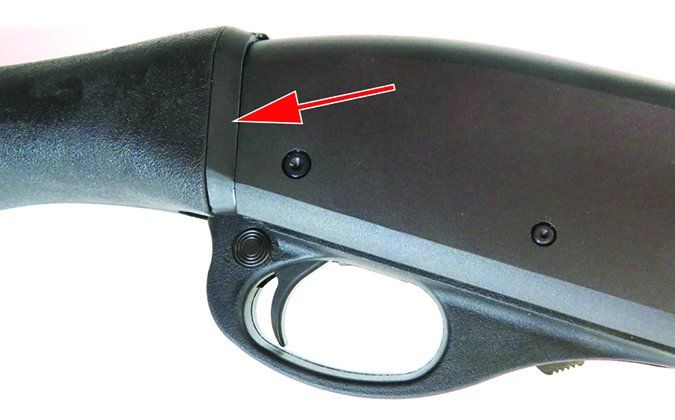
Like the 20-gauge Mossberg, the Remington TAC-14 is built on a scaled down 20-gauge receiver, the Model 870 in this case. Out of the box, it wore a matte finish that was well executed. The action was also super slick. The Raptor grip lacked a swivel stud for a sling, and there was a transitional piece between the grip and the receiver which was not aesthetically pleasing. The transitional piece attached the receiver to the grip. We preferred the arrangement on the Mossberg. The forend was a Magpul MOE M-LOK model of molded polymer.
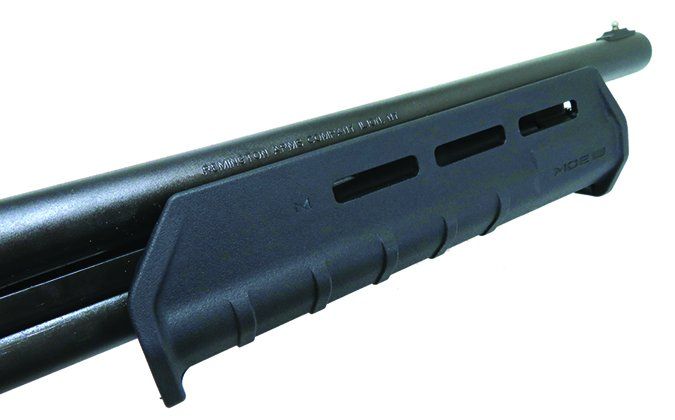
The grip surface was nicely ribbed and featured a flared edge at the front and rear so your hand did not slip toward the muzzle nor between the receiver and the forend when cycled. The strap on the Mossberg provided more grip security, especially when cycled fast and dealing with recoil. The trigger guard/trigger group was made of polymer, with “Remington” molded on the outside of the trigger guard. The safety is located behind the trigger guard, as it is with all Model 870 shotguns. The plain barrel is 14 inches in length and features a plain brass bead for sights. The slide-release button is also like other model 870s, in front of the trigger guard on the left-hand side. As mentioned, whether you were a Model 870 shooter versus a Model 500/590 shooter decided what brand you preferred. The Remington had the best trigger of all three weapons tested, our testers said.
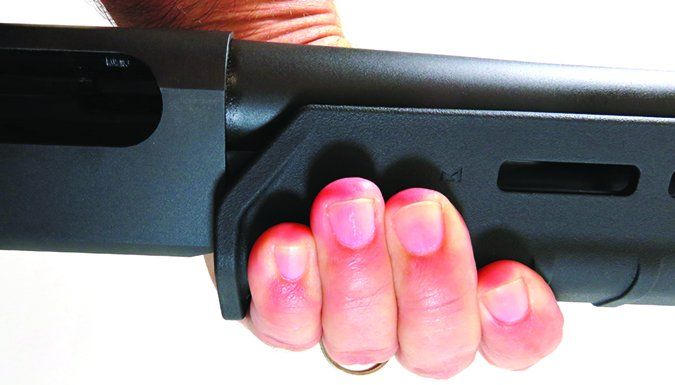
We loaded the TAC-14 using the same two techniques as employed on the Mossberg and found it was easy to load and easy on our thumbs. There were no sharp edges, and we became efficient at loading it fast. We also became efficient at shooting it fast using the three shooting techniques. Recoil was mild and pleasant. We could shoot the TAC-14 easily one handed, but we noted fatigue soon started with a 5-pound weapon being held in one hand. The Mossberg 20 gauge was similar in effect.
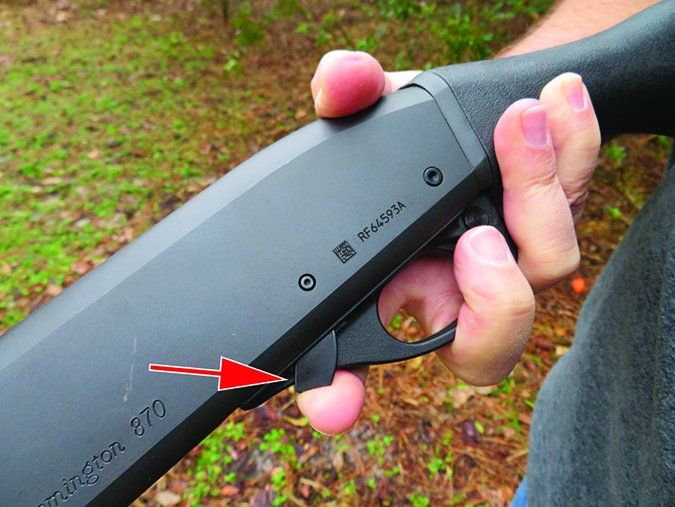
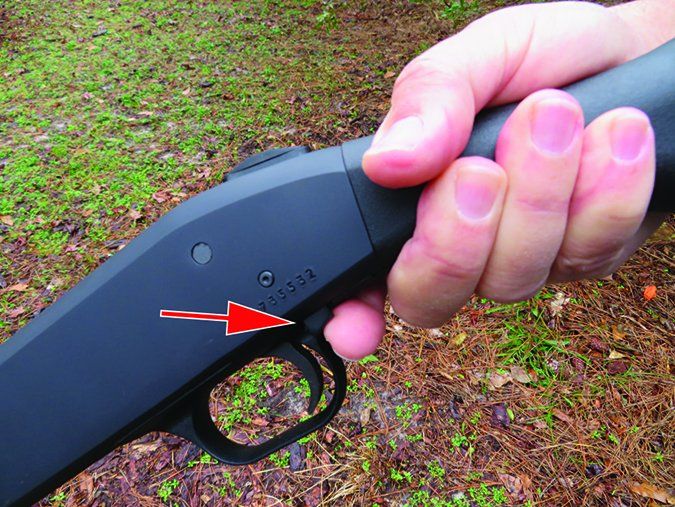
The TAC-14 gave us similar patterns with the birdshot, 17 inches. Compared to the Mossberg, the buckshot load opened up to 6 inches, and the rifled slugs shrunk to 3 inches. We were quite pleased with the TAC-14’s accuracy and our ability to fire it for accuracy and speed. We’d use buckshot in the TAC-14 and would investigate different loads to see which offered the tightest pattern.
Our Team Said: Model 870 fans, if you are looking at one of these weapons for home defense, consider the TAC-14. We’d load it with buckshot and rest peacefully at night knowing we had a tool good enough to stop any intruders.
Mossberg 590 Shockwave Model 50649 410 Bore, $455
GUN TESTS GRADE: A
This Shockwave was easy to handle and offered little recoil. Loaded with one of the specialty 410 defense loads, this would make a good home-defense choice.

| ACTION TYPE | Pump |
| CHAMBER SIZE | 3 in. |
| OVERALL LENGTH | 26.37 in. |
| CAPACITY | 5+1 (2.5-in. shells), 4+1 (3-in. shells) |
| WEIGHT UNLOADED | 4.24 lbs. |
| WEIGHT LOADED | 5.04 lbs. |
| BARREL LENGTH | 14 lbs. |
| FINISH | Matte blued |
| CHOKE | Cylinder bore |
| GRIP | Bird’s head-style, textured polymer |
| FOREND | Ribbed polymer w/ strap |
| FRONT SIGHT | Brass bead |
| TRIGGER PULL WEIGHT | 5.3 lbs. |
| SAFETY | Ambidextrous thumb |
| WARRANTY | Limited lifetime |
| TELEPHONE | (800) 363-3555 |
| WEBSITE | Mossberg.com |
| MADE IN | USA |
The Mossberg 410 Shockwave is based on the 410-scaled receiver for the Model 500 and Model 590 shotguns. It is lithe and petite in hand. It weighed about a pound less than the 20-gauge weapons.
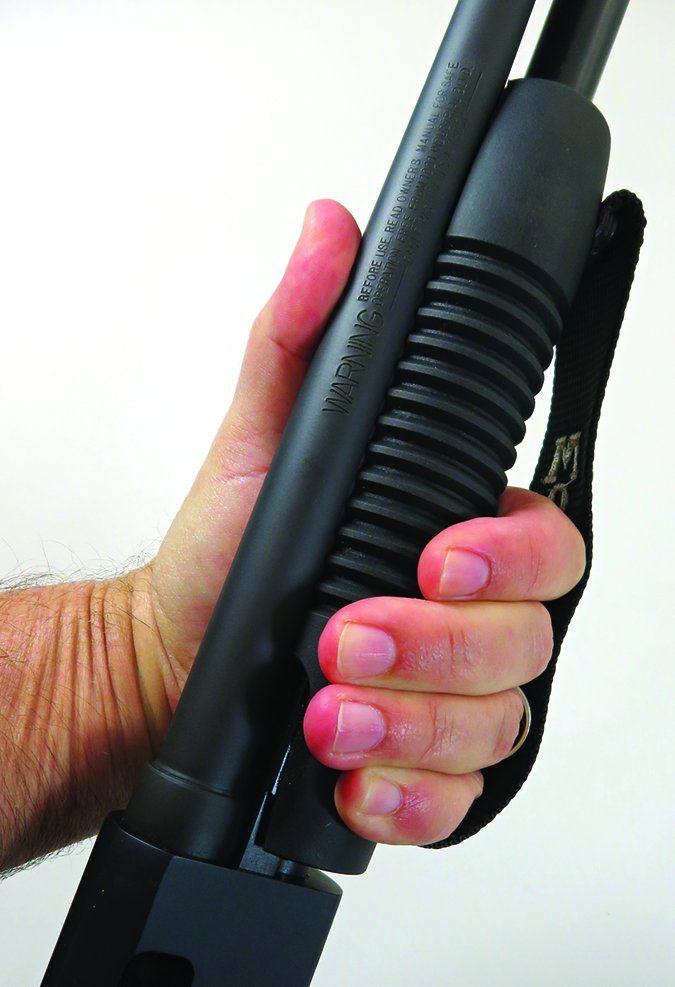
The 410 Shockwave was essentially a scaled-down version of the 20-gauge Shockwave. The smaller Raptor grip flowed seamlessly into the smaller receiver, and the 14-inch plain barrel wears a brass bead. The forend is slightly skinnier than the 20 gauge variant, and it was coarsely ribbed and featured a strap. Though the recoil of the 410 Shockwave did not necessitate a real need for the strap, we grew accustomed to it and relied on it just as we did on the 20-gauge version.
The action was slick. Kudos to Remington and Mossberg for making the actions super slick to cycle. Where we found a difference in the 410 compared to the 20-gauge variant was in loading. The loading port of the 410 Shockwave is similar in size to the 20-gauge variant, but the 410 shell is narrow and needs to be aligned with the magazine. You just can’t drop the shell in the port and push it in with your thumb as you could with the 20 gauge variant. There was a bit of finagling to push the skinny 410 shell in the magazine tube, which slowed down reloading.
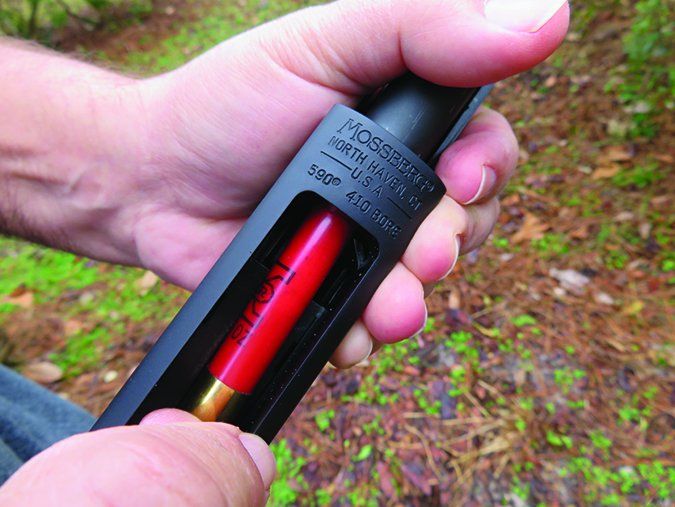
Another trade-off with the 410 version versus the 20 gauge is less power/penetration in a smaller package. But that is not necessarily a bad thing because there are now numerous 410 specialty loads developed for revolvers like the Taurus Judge and S&W Governor. We cannot think of another situation in which handgun spurred ammunition manufacturers to develop shotgun loads specifically for defense.
During testing, we noted mild recoil with the 410 bore and a tighter 10-inch pattern with birdshot. We’d definitely not use birdshot in a home-defense situation unless we were shooting at snakes or rodents, which itself seems unwise to blow a hole in the floor or walls to kill a rat. Maybe in a barn or out-building birdshot makes more sense for vermin.
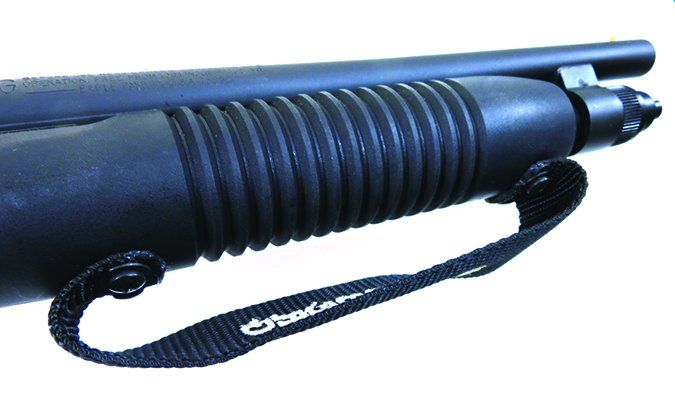
For self-defense use in the home, we’d stoke the 410 with Hornady Critical Defense loads, which feature an FTX slug and two round balls for projectiles. These patterned a tight 3 inches at 10 yards. We were also able to group slugs at 3.25 inches at the test distance. From across the width or length of a room, the 410 can provide serious defensive power with minimal recoil.
When we fired the 410 one handed, there was not enough recoil to force the forend rearward as there was with the 20-gauge weapons. The action was slick, and we could easily rapid-fire the 410 using the Rib Cage Hold or the Hip Hold. Since the 410 Shockwave was lighter, it was easy to hold one handed. No need for Navy SEAL biceps with this petite shooter.
Our Team Said: The 410 was smaller and lighter, yet with specialty loads, we’d feel comfortable using it in a self-defense weapon. If you or someone in your household is recoil shy, the 410 is an excellent choice.
Shooting These Sub-Gauge Shorties
In our experience with Shockwave-style shotguns, there is a tendency to pull the grip close to your face. This can happen with shooters experienced with pump-action shotguns, especially after the first shot when they cycle the shotgun for a follow-up shot. It is habit to bring the firing hand and grip back to set the stock in your shoulder after cycling the slide with your support arm.
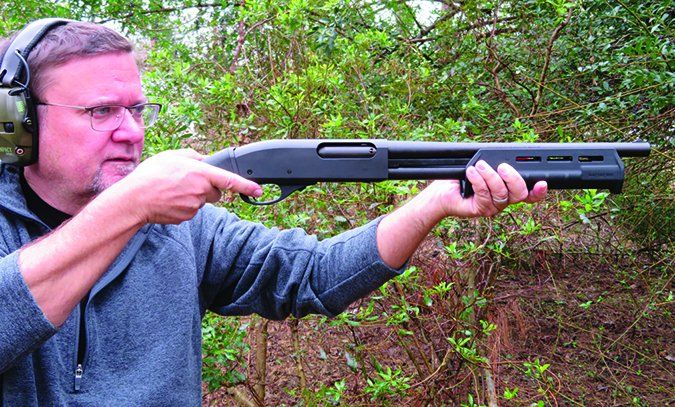
With a Shockwave-style weapon, the recoil does not go into your shoulder as it does with a pump shotgun. Recoil comes straight back, and if your firing hand is close to your face, you run the risk of getting whacked in the face as the weapon recoils. This is especially true of the Mossberg and Remington guns chambered in 20 gauge. The Mossberg in 410 has less recoil, and a more experienced shooter could put the gun closer to his face without risk. Obviously, the risk is even greater with a 12-gauge model, so we don’t advocate trying it unless you want to make an ER run.
Firing these weapons is not like shooting a handgun or long gun. They are hard to aim and keep a steady hold with, but remember that these weapons were made for close quarters work, offering maneuverability and the power of multiple projectiles. They are designed to shoot fist-sized groups firing off hand. We found three ways to shoot these weapons with consistency and without the risk of recoil cracking a jawbone.
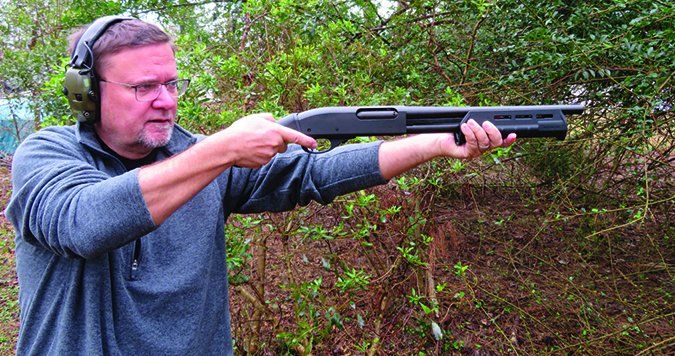
The first technique we call the Reverse Pump. Instead of using your support arm to pump the weapon, keep your support arm out and locked and use your firing grip to push the weapon forward to cycle the action. This ensures the weapon stays far enough from your face to avoid recoil, yet still allows you to use the bead sight to aim. We found the strap on the Mossberg Shockwaves allowed us to cycle the weapon easier than the TAC-14 using this style. The strap traps the support hand on the forend, so even if your support hand slips, it is still affixed to the forend via the strap and allows you to cycle the weapon. The TAC-14 forend has a nice raised edge at the front and rear of the forend that serves a similar purpose, but does not hold your support hand as securely as the strap on the Mossberg. We found this technique allowed us to aim more precisely.
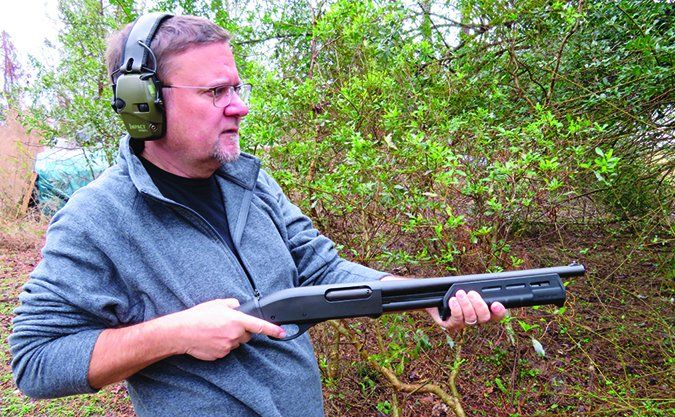
The second technique is the Ribcage Hold. Hold the grip to the side of your ribcage between your arm pit and waist. This hold keeps the muzzle perpendicular to the target, and at close range we found this technique effective in keeping projectiles on target and also allowed for fast follow-up shots. With the Ribcage Hold, you can pump the action as you would a typical pump shotgun. This is perhaps the easiest way to shoot these weapons at close-range targets without a skill-set change like that needed with the Reverse Pump method. Recoil also pushes rearward along the side of your body with your arms absorbing the motion.
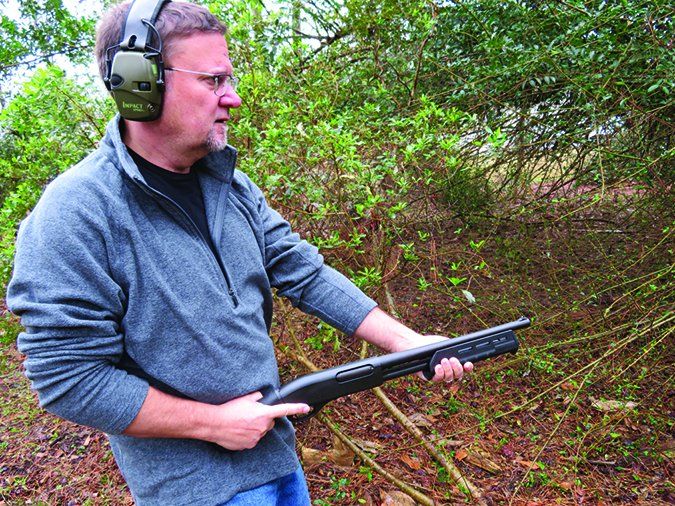
The Hip Hold technique is similar to the Ribcage Hold except you place the grip in front of your hip. We found this hold was comfortable with the 20-gauge and 410-bore choices. With a 12-gauge shorty and using 2.75-inch shells or larger, the recoil can be severe. With mini shells, recoil is similar to the 20-gauge models. With this technique you need to be more aware of your muzzle, so load power could affect how the shotgun reacts. Between shots, the support hand does the pumping and aiming. Some testers fired too high initially until they got a feel for the technique.
Written and photographed by Robert Sadowski, using evaluations from Gun Tests team testers.
Special thanks to Eastern Outfitters of Hampstead, North Carolina, for their assistance.
























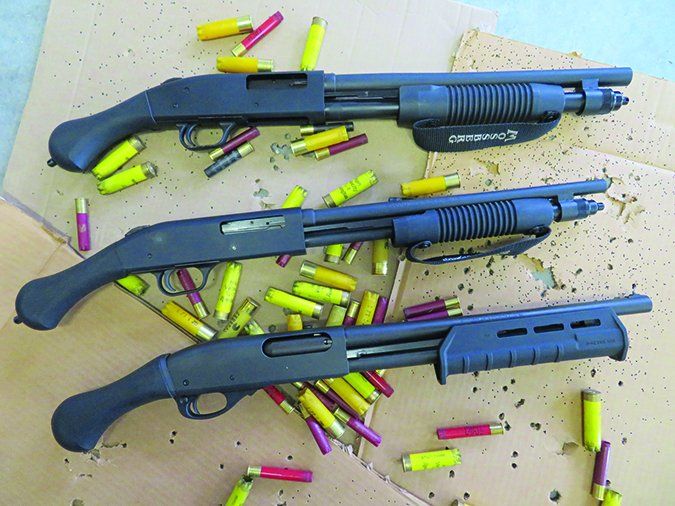
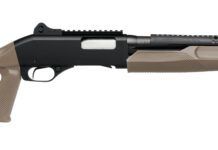


I would love one of these for home defense, but afraid my home state will outlaw them
IMO, HD range (in an average home) is more like 3-4 yards, or even 6-10 feet..
See YouTube for the actual lethality of birdshot – and
consider how much indoor -and outdoor- destruction
(and bystander legality/lethality) you can tolerate with
the penetration of buckshot and its fliers.
I such a case I would prefer a well-chosen firing angle
(crouch low, aim upward, for suburban neighborhood safety);
and a single projectile, like a handloaded ball.
“We’d definitely not use birdshot in a home-defense situation ”
unless you cared about your walls… or killing your neighbors…
😉
Seriously, check out you tube on birdshot lethality.
& Then there’s cut shells.
-RTH